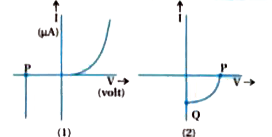Consider an n-p-n transitor with its base-emitter junction forward biased and collector base junction reverse biased. Which of the following statements are true? Solution in Gujrati
Electrons crossover from emitter to collector.
Holes move from base to collector.
Electrons move from emitter to base.
Electrons from emitter move out of base without going to the collector.
The correct Answer is:A, C
In common base connection, majority of electrons (nearly 95%) going from emitter to base, enter into collector. Thus, option (A) is correct.
In above case, small no. of electrons (nearly 5%), going from emitter to base, combine with the holes in base. Thus, option (C ) is also correct.
Topper's Solved these Questions
- BOOK - KUMAR PRAKASHANCHAPTER - SEMICONDUCTOR ELECTRONICS : MATERIALS, DEVICES AND SIMPLE CIRCUITS EXERCISE - Section-C: NCERT Exemplar Solution (Very Short Answer Type Questions)6videos
SEMICONDUCTOR ELECTRONICS : MATERIALS, DEVICES AND SIMPLE CIRCUITS
- BOOK - KUMAR PRAKASHANCHAPTER - SEMICONDUCTOR ELECTRONICS : MATERIALS, DEVICES AND SIMPLE CIRCUITS EXERCISE - Section-C: NCERT Exemplar Solution (Short Answer Type Questions)8videos
SEMICONDUCTOR ELECTRONICS : MATERIALS, DEVICES AND SIMPLE CIRCUITS
- BOOK - KUMAR PRAKASHANCHAPTER - SEMICONDUCTOR ELECTRONICS : MATERIALS, DEVICES AND SIMPLE CIRCUITS EXERCISE - Section-C: NCERT Exemplar Solution (Multiple Choice Qustion (MCQs) )8videos
SEMICONDUCTOR ELECTRONICS : MATERIALS, DEVICES AND SIMPLE CIRCUITS
- BOOK - KUMAR PRAKASHANCHAPTER - SAMPLE QUESTION PAPER EXERCISE - PART-B SECTION-C5videos
SAMPLE QUESTION PAPER
- BOOK - KUMAR PRAKASHANCHAPTER - WAVE OPTICSEXERCISE - SECTION-D (MULTIPLCE CHOICE QUESTIONS (MCQS)) (MCQS FROM DARPAN BASED ON TEXTBOOK)239videos
WAVE OPTICS
Similar Questions
Why are elemental dopants for Silicon on Germanium usually chosen from group XIII on group XV ?
05:07View Solution
(i) Name the type of a diode whose characteristics are shown in figure (1) and figure (2).
(ii) What does the point P in figure (1) represent?
(iii) What does the points P and Q in figure (2) represent?01:31View SolutionThe conductivity of a semiconductor increases with increase in temperature because
02:13View SolutionTwo charges –q and +q are located at points (0, 0, –a) and (0, 0, a), respectively.
(a) What is the electrostatic potential at the points (0, 0, z) and (x, y, 0) ?
(b) Obtain the dependence of potential on the distance r of a point from the origin when r/a>>1 .
(c) How much work is done in moving a small test charge from the point (5,0,0) to (–7,0,0) along the x-axis? Does the answer change if the path of the test charge between the same points is not along the x-axis?01:58View SolutionAccording to particle theory of light what is the velocity of light in a dense medium, compared to that in rare medium ?
05:10View SolutionConsider an n-p-n transistor with its base - emitter junction forward biased and collector base junction reverse biased . Which of the following statements are true?
04:20View SolutionThe emitter-base junction of a transistor is .........biased while the collector-base junctio is.......biased
11:09View SolutionIn the working of a transisor, emitter-base junction is forward biased while collector-base junction is reverse biased. Why?
View SolutionIn a normal operation of a transistor,
(i) base-emitter junction is forward-biased
(ii) base-collector junction is forward-biased
(iii) base-emitter junction is reverse-baised
(iv) base-collector junction is reverse-biased04:23View SolutionThe emitter base junction is forward biased and the base collector junction is reverse biased, in order to use a transistor as
05:34View SolutionConsider an n-p-n transistor with its base -emitter junction forward biased and collector -base junction reverse biased. Which of the following statements are true ?
View SolutionIn a transistor emitter-base junction is always forward biased while the collector-base junction is reverse biased. Why ?
04:22View SolutionDescribe briefly with the help of a circuit diagram, how the flow of current carriers in a p-n-p transistor is regulated with emitter-base junction forward biased and base-collector junction reverse biased
01:58View SolutionConsider an n-p-n transistor with its base - emitter junction forward biased and collector base junction reverse biased . Which of the following statements are true?
01:32View SolutionDescribe briefly with the help of a circuit diagram, how the flow of current carriers in a p-n-p transistor is regulated with emitter-base junction forward biased and base-collector junction reverse biased.
01:31View Solution

